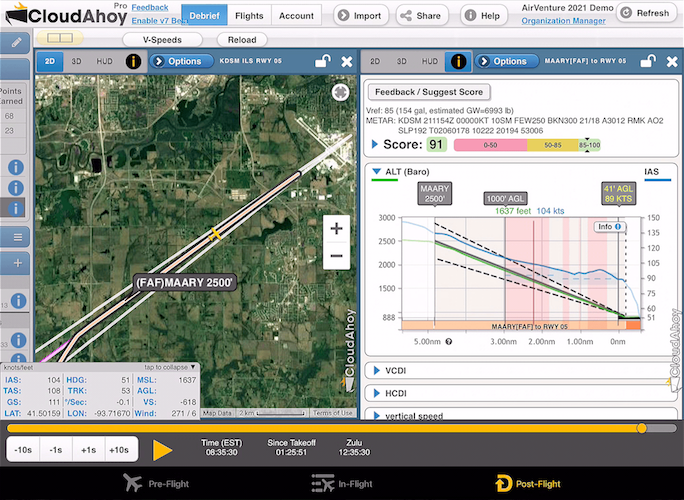Opinion: Will Flight Data Monitoring Transform Safety?

While flight data monitoring (FDM) or FOQA (Flight Operational Quality Assurance) has been around in the commercial airline industry for decades, business aviation has been much slower to adopt this technology, for many reasons.
Many say FDM hasn’t taken off in business aviation due to pilot concerns over “tattle-tales” or having “Big Brother” in the cockpit The reasons, however, are much more complicated than company culture and the trust between pilots and management.
FDM first requires access to flight data, which requires hardware that both records flight data and has a means to export it. Once all the flight data has been accessed, the next step is in aggregating and using it.
In the past, this process is more complicated than the act of extracting the data itself. Sophisticated FDM/FOQA programs can use thousands of data points and track hundreds of operational metrics, and airlines can have teams of analysts working through the mountains of data being pushed from their fleets.
The thought of establishing an FDM program has seemed out of reach for most small and medium fleet operators, but we are now seeing the first glimmers of industry-wide adoption of FDM coming to light.
Flight data recorders are standard in modern aircraft, and providers of data exporting and analysis services are beginning to focus on business aviation as their next sales target, scaling the costs to the business size.
Use Case: Stabilized Approaches
While the use cases for FDM are almost limitless, one of the best applications of this technology is the monitoring of stabilized approaches.
Approach and landing is a critical phase of flight and represents up to 61% of aircraft accidents, according to ICAO’s 2014 safety report. Mitigating the risks of landing failures results in significantly reduced incidents and accidents.
In addition to passenger and crew safety, a hard landing or runway overrun can cost an operator months of downtime and expensive repairs to critical components, such as the aircraft’s landing gear. It can also cost an operator’s reputation in the industry.
The consistent use of stabilized approaches has proven to significantly reduce these failures and has been commonplace in the airline and business aviation world for years.
The concept of stabilized approaches arrived with the advent of large jet-engine powered aircraft. Unlike their slower piston and turboprop predecessors, jet aircraft require more time to configure for landing.
A measured, slower approach to the airfield gives crews more time to establish ideal speeds and equipment configurations along with a plan to abort when the aircraft is not in the ideal setup for landing.
By using FDM/FOQA in their operations, airlines consistently use aggregate data to identify systemic issues that lead to unstabilized approaches. FDM can uncover issues in airport approach systems, aircraft system issues, crew training, and procedures and can provide crew members with a rich, non-punitive, interactive debrief of the approach.
Part 135 and other business aviation operators fly into a much larger variety of airports and more complex operational environments. Flight data monitoring and aggregated data from multiple operators across the industry, would have a major impact on reducing mishaps and accidents in business aviation.
Accessibility And Scalability
In the past, small operators and most business aviation operations lacked access to FDM tools that would require a fleet of data analysts and programmers to translate and a massive investment in hardware. However, many affordable tools are now coming to market for smaller operations, providing them access to their own data and de-identified data of larger fleet operators.
The Air Charter Safety Foundation, a non-profit safety organization, is currently beta-testing an FDM program for a small group of members. The data is collected from an AirSync device that can be used on a variety of Garmin cockpits and installed in a matter of minutes. From there, the flight data is sent via Wi-Fi to a data analysis platform, CloudAhoy.
The debrief dashboard in CloudAhoy aggregates the cockpit data, airport approach information, air traffic control communications and weather in one visualization page, with a performance score. This functionality is a game-changer for safety managers to review aggregate data looking for systemic issues that can then drive changes in company procedures and training programs.
The ability to stop, rewind, add data layers and review gives safety teams rich and detailed flight information that would be impossible to capture in any other way.
Many other options are also available.
GE Digital Aviation offers a C-FOQA (Corporate FOQA) platform featuring flight analysis tools and integrations with data from other operators, such as Gulfstream, Collins Aerospace and the Polairus Aero safety management system.
Once operators get into a data analysis system, they can begin to contribute data to and review data from the FAA’s ASIAS (Aviation Safety Information Analysis and Sharing) network.
Today, the number of business operators in ASIAS is small, but it is quickly gaining traction, particularly with large fractional fleet operators and corporate flight departments.
The future seems bright for FDM as cost-effective solutions to collect and analyze data come to market.
Beyond flight data, the use of simulator training data through SOQA (simulator operational quality assurance) could further enhance the skill level of the industry’s pilots and its systems. Data analysis can give business aviation the ability to predict and mitigate failures before they result in an accident.
Now, that’s something the entire industry can get behind.
Jessie Naor is COO of GrandView Aviation, a Part 135 charter operator. She currently serves on the executive committee of the Air Charter Safety Foundation and vice-chair of the National Air Transportation Association’s Part 135 committee. Jessie has participated in FAA rulemaking committees and has received the NBAA’s Top 40 Under 40 Award in 2020.